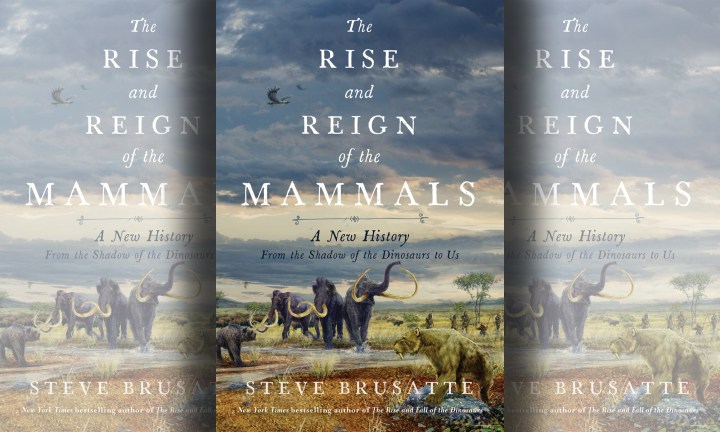BOOK REVIEW
We are creatures of coal — an evolutionary tale dripping with irony

One of the most striking takeaways from Steven Brusatte’s ‘The Rise and Reign of the Mammals’, was that all mammals, ourselves included, are creatures of coal. One quibble is that Brusatte falls into the trap of judging our prehistoric ancestors through a 21st-century prism.
The Rise and Reign of the Mammals by Steven Brusatte is a highly entertaining and informative romp through the evolutionary history of the warm-blooded beasts that now rule the planet. It all began in the coal swamps, an ancient and sweltering ecosystem that would have an outsized impact on the planet’s subsequent natural history. “… around 325 million years ago … there was an ancestral stock of small, scale-covered critters that lived in lush swamp forests, which were frequently inundated by rising seas. They split apart, with one side of the family tree leading to reptiles and the other toward mammals,” Brusatte writes. “These were the coal swamps, so-called because much of the coal that fuelled the Industrial Revolution … formed in these very swamps.”
And in those same swamps, our distant ancestors emerged, an evolutionary tale dripping with irony as humanity’s use of the fossil fuel that originated in tandem with our lineage is now tipping the planet into a climate disaster that could potentially derail the reign of the mammals.
Some of the early evidence for this has been unearthed in a disused coal mine in this reviewer’s Canadian home province of Nova Scotia, which today is usually not associated with tropical swamps. The key species, Archaeothyris – which means “ancient window” – speaks to its most insightful feature: “… its large, porthole like opening behind its eye, which houses larger and more powerful jaw-closing muscles than its ancestors.”
This is what defines a “synapsid”, a group of animals that today are far more commonly known as “mammals.”
Along the way, mammals had some close calls, evolving in the shadow of the dinosaurs which towered over our mostly puny ancestors until an asteroid ended their reign around 66 million years ago. That same asteroid could also have been the end of the line for us.
“Mammals almost died out. They nearly went the way of the dinosaurs. All they had accomplished – their entire evolutionary legacy, of hair and milk, jaw bones turned to ear bones, and all those varieties of teeth – was almost lost forever … It was a close call, and it all hinged on what happened in the days, decades, and millennia after the asteroid impact,” Brusatte tells us.
Indeed, it seems that most mammals did go the way of the dinosaurs in the wake of the asteroid’s nightmarish aftermath which included a long “impact winter” that thwarted photosynthesis in plants and plankton.
“This begs the question: what allowed some mammals to survive?” Brusatte asks. “The answer is apparent when looking at the victims and survivors.”
Size matters, and the survivors tended to be smaller, with teeth that indicated a wide-ranging, omnivorous diet.
“The victims, on the other hand, were larger species, with more specialist carnivorous or herbivorous diets … They were supremely adapted to the latest Cretaceous world, but when the asteroid threw everything into anarchy, these adaptations became handicaps. The smaller generalists, however, were able to take advantage of their flexible palate to eat whatever was on offer – probably little more than seeds, decaying vegetation, and rotting flesh.”
From such a bleakly unpromising situation the mammals would displace the dinosaurs and the rest, as say they, is natural history.
Brusatte also weaves a colourful cast of characters into his narrative: fossil hunters are an interesting bunch. But one of the many things this reviewer learned was that Native Americans had long been familiar with fossils and had various explanations for their existence.
However, credit for the first recorded discovery of fossils of extinct mammals in North America – mammals that were recognised for what they were – belongs to African slaves who were toiling in a swamp in South Carolina around 1725 when they made a startling find.
“The slaves,” Brusatte writes,”… knew exactly what these things were.”
“The objects were teeth. Elephant teeth … The slaves were familiar with elephants, having lived alongside them back home in Africa. There were no elephants in the Carolina swamps, though, or anywhere else on the American continent, as far as anyone knew at the time. These were exotic, foreign animals. One can imagine the disbelief on the faces of the plantation owners. Preposterous! The slaves must be wrong.”
Of course, the slaves were right – the teeth belonged to a relative of the African elephants, the mammoth. Thomas Jefferson, author of the Declaration of Independence and the young American republic’s third president, developed an obsession with mammoths, which he long believed might still exist in the continent’s remote west.
The mammoths went extinct with a host of other large mammals in the Americas and elsewhere – extinction events that generally coincided with the arrival of Homo sapiens. Our ancestors, in the view of many scientists, triggered a global tsunami of large-animal extinctions after migrating from Africa tens of thousands of years ago.
On this topic, Brusatte strides the middle of the raging debates over these extinctions. In recent years the scientific scale has been tipping in favour of the “Overkill hypothesis” which holds that human Paleo hunters hunted the big beats to extinction. Climate change is seen as the other cause.
“As the debate about megafauna extinction continues, there is growing realisation that it was probably humans and climate, working in tandem, which spell doom,” Brusatte writes.
This reviewer has raised the possibility that if anthropocentric hunting was indeed a cause of the pre-historic megafauna extinctions that unfolded from around 130,000 to 10,000 years ago, that it may have been rooted in human-wildlife conflict. Most of the big animals that met their doom were also potentially dangerous from a human vantage point.
On this front, Brusatte falls into the trap that has coloured much of the discourse on the issue, placing the human-triggered megafauna extinctions as among humanity’s “sins.”
“It comes down to this: if our human species had not spread around the world, then a lot of megafauna would still be here … For mammoths and sabertooths, we were the asteroid.”
Brusatte goes on to say that work on cloning or bringing mammoths back to life – which are far from far-fetched – provide an opportunity for atonement.
“… if it does happen, it will give us that rarest of opportunities … a chance to make amends for our sins, and resurrect something that would still be alive, if not for us.”
This, I feel, is a high-brow 21st-century judgment rendered on Paleo peoples – accused of committing “sins” nogal – who were simply trying to survive in a menacing faunal environment that must have been rife with human-wildlife conflict. It’s like affluent western suburbanites today tut-tutting about poor rural Africans who kill lions or elephants that pose a direct danger to their kith, kin, cattle or corn. Westerners cry for lions, Africans generally don’t.
Viewed through this prism, it may be useful to revisit our framing of the concept of the “Anthropocene” (a term that Brusatte curiously doesn’t use). This refers to our current epoch and humanity’s massive and unfolding impact on the planet’s ecosystems – we have certainly been “creatures of coal” in more ways than one.
Some scientists say that the Anthropecene’s roots lie in the pre-historic megafaunal extinctions, drawing a straight projectile from the archaic stone or wooden ones that may have felled mammoths to our modern global economy. There is probably a lot of truth to that: those extinctions had huge ecological consequences which in turn have had historical consequences that still cry out for study.
But it also tends to frame the “Anthropocene” as an unremitting saga of human avarice and wanton destruction. In reality, it has been far more complicated and interesting than that. And a good way to start would be to stop regarding our distant ancestors as “sinners”. DM/ ML/OBP




















 Become an Insider
Become an Insider
A fair review of a complex natural history.